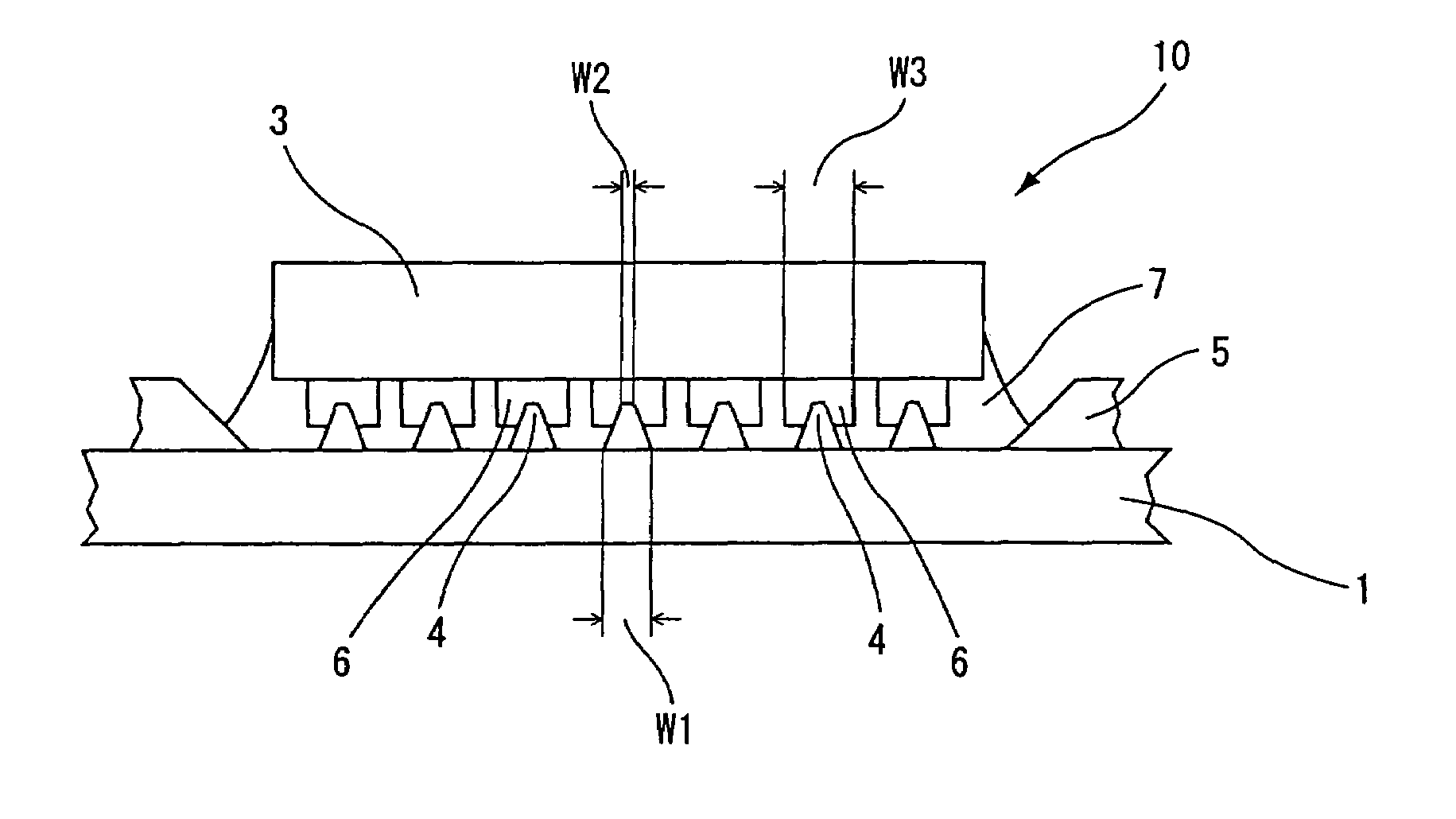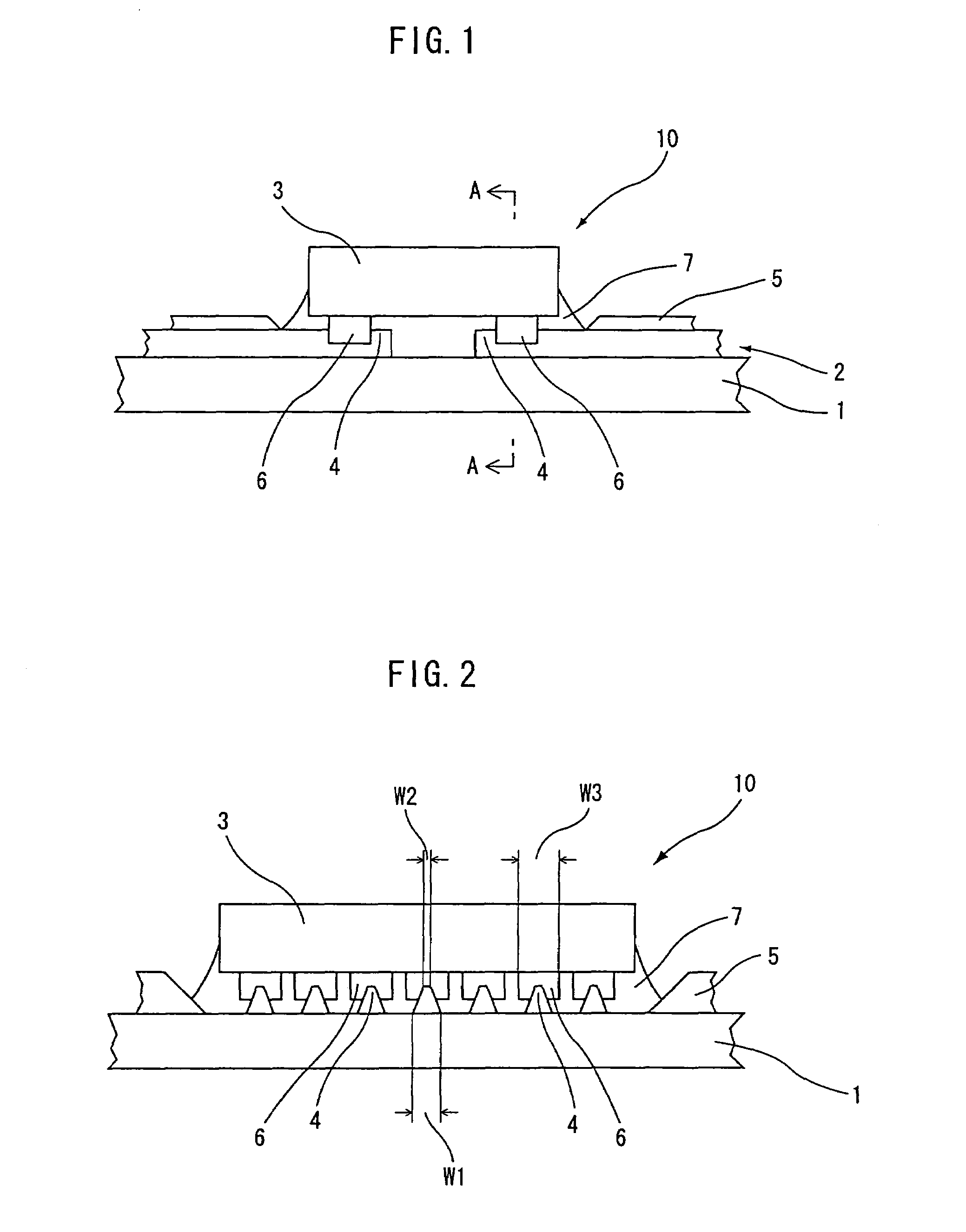Semiconductor device and production method therefor
a technology of semiconductors and semiconductors, applied in the direction of multiple way valves, mechanical equipment, engine components, etc., can solve the problems of insufficient electrical connection, cumulative dimensional differences between the interconnection pattern and the bump electrode, and liable deformation of the interconnection pattern, so as to prevent the edge from touching
- Summary
- Abstract
- Description
- Claims
- Application Information
AI Technical Summary
Benefits of technology
Problems solved by technology
Method used
Image
Examples
second embodiment
[0079]A semiconductor device production method according to a second embodiment is a modification of the semiconductor device production method according to the first embodiment. In this production method, the semiconductor device 10 (see FIGS. 1 and 2) is produced in substantially the same manner as in the production method according to the first embodiment, except that the semiconductor chip pressing and heating step is modified. Therefore, no explanation will be given to the step of positioning and mounting the semiconductor chip 3 on the resin 7 and the steps precedent thereto (see FIGS. 3(a) to 5(a) and FIGS. 3(b) to 5(b)), and only the step of pressing and heating the semiconductor chip 3 will be described with reference to FIGS. 8(a), 8(b), 9(a) and 9(b).
[0080]In the second embodiment, as shown in FIGS. 8(a) and 8(b), the semiconductor chip 3 is pressed against the film substrate 1 at a pressure of about 250×10−4 gf / μm2 and heated at about 230° C. to about 250° C. for about 1...
third embodiment
[0082]The construction of a COF semiconductor device according to a third embodiment of the present invention will be described with reference to FIG. 10. FIG. 10 is an enlarged partial view of the COF semiconductor device according to the third embodiment.
[0083]The COF semiconductor device according to the third embodiment has substantially the same construction as the semiconductor device 10 according to the first or second or embodiment (see FIGS. 1 and 2), except that alloy layers 38 of an alloy of metal materials for the projections 4 and the bump electrodes 6 are present in connection interfaces between the projections 4 of the interconnection pattern 2 and the bump electrodes 6 as shown in FIG. 10. Thus, the connection reliability is further improved.
[0084]A semiconductor device production method according to the third embodiment is substantially the same as the production method according to the first embodiment, except that the semiconductor chip pressing and heating step i...
fourth embodiment
[0090]The construction of a COF semiconductor device according to a fourth embodiment of the present invention will be described with reference to FIGS. 14 and 15. FIG. 14 is a diagram schematically illustrating the construction of the COF semiconductor device according to the fourth embodiment, and FIG. 15 is a sectional view of the COF semiconductor device taken along a line B—B in FIG. 14.
[0091]As shown in FIGS. 14 and 15, the COF semiconductor device 40 according to the fourth embodiment has substantially the same construction as the semiconductor device 10 according to the first or second embodiment (see FIGS. 1 and 2), except that a resin portion 47 provided between the semiconductor chip 3 and the film substrate 1 contains conductive particles 49 dispersed therein. Some of the conductive particles 49 are present in the connection interfaces between the projections 4 of the interconnection pattern 2 and the bump electrodes 6, whereby the connection reliability is further impro...
PUM
 Login to View More
Login to View More Abstract
Description
Claims
Application Information
 Login to View More
Login to View More - R&D
- Intellectual Property
- Life Sciences
- Materials
- Tech Scout
- Unparalleled Data Quality
- Higher Quality Content
- 60% Fewer Hallucinations
Browse by: Latest US Patents, China's latest patents, Technical Efficacy Thesaurus, Application Domain, Technology Topic, Popular Technical Reports.
© 2025 PatSnap. All rights reserved.Legal|Privacy policy|Modern Slavery Act Transparency Statement|Sitemap|About US| Contact US: help@patsnap.com



